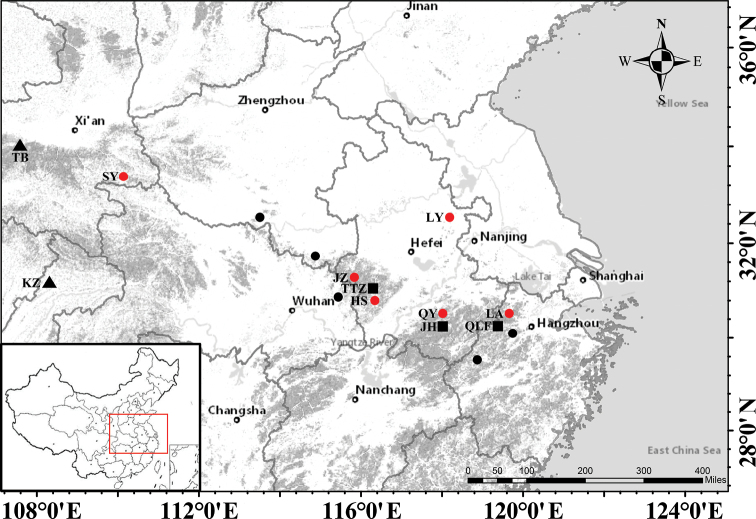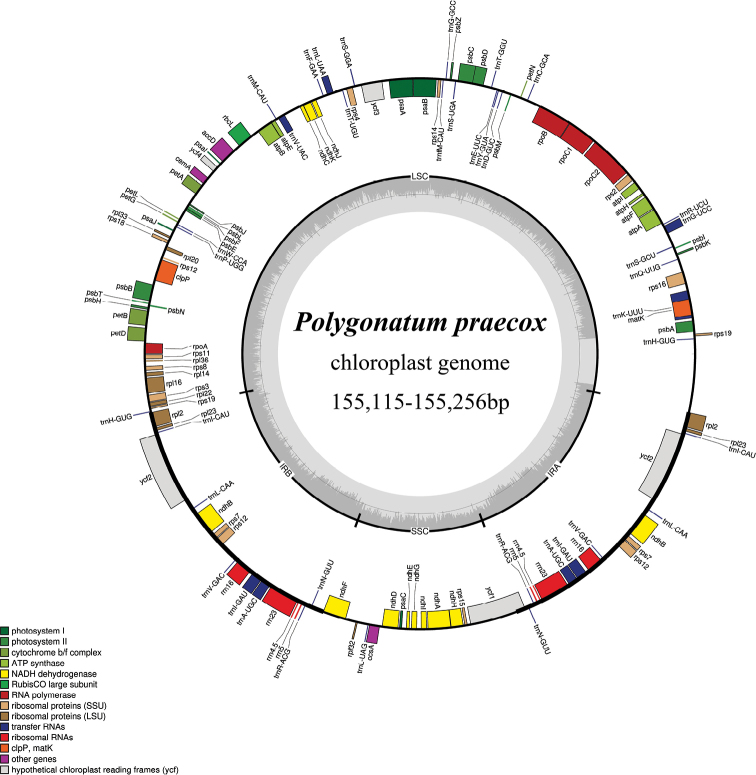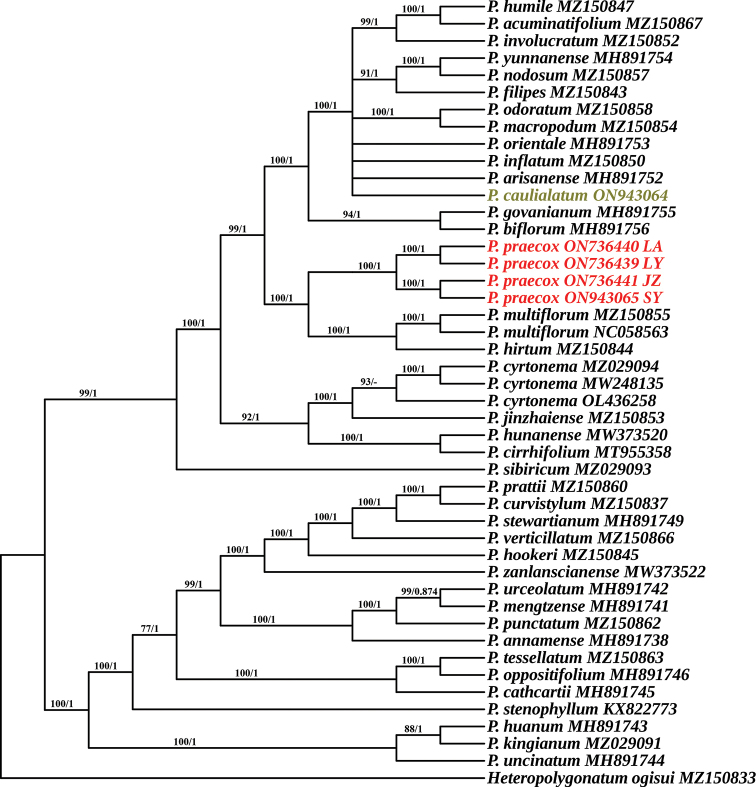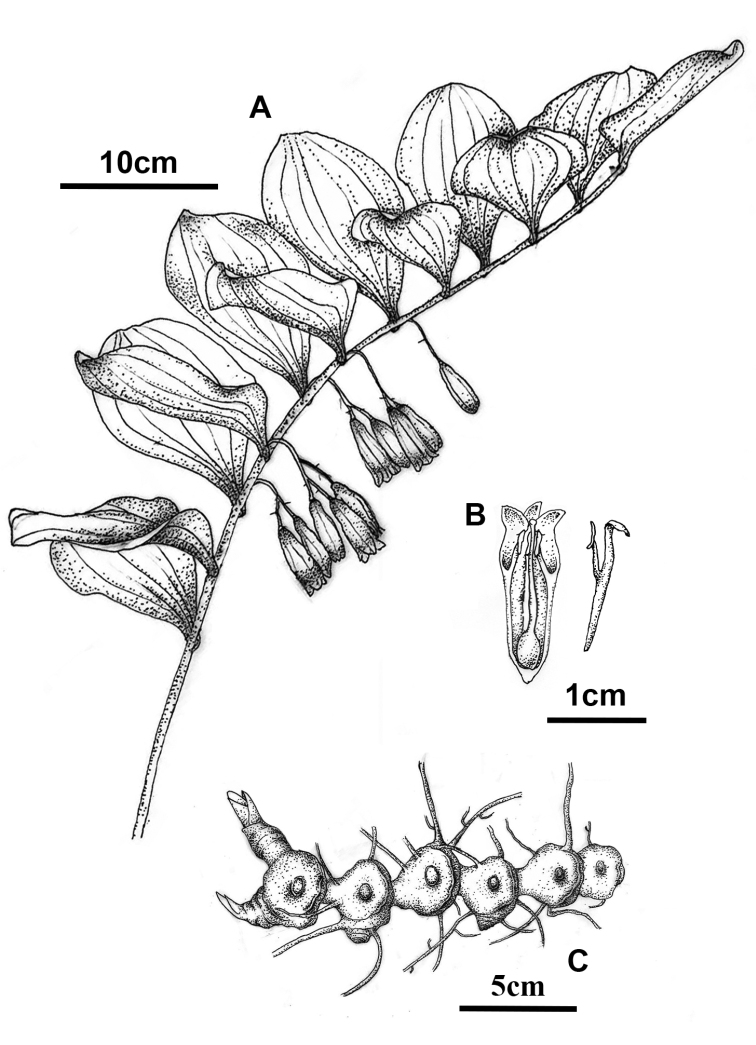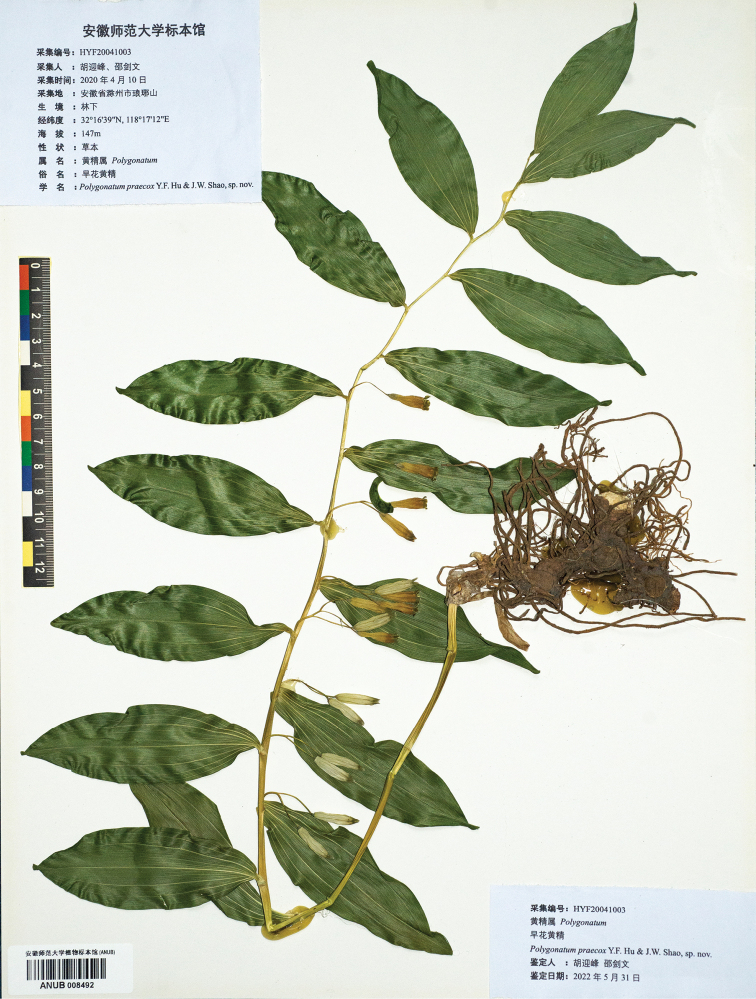Abstract
A new species, Polygonatumpraecox Y.F.Hu & J.W.Shao (Asparagaceae), is described and illustrated. This species is similar to P.cyrtonema, P.odoratum and P.caulialatum, but can be distinguished from P.cyrtonema by its racemose inflorescence, cylindrical hairless filaments and apex without a retrorse spur; from P.odoratum by its stout moniliform rhizome, straight stem and longer (1.7–2.2 cm long) floral tube; and from P.caulialatum by its upper part straight stem, yellowish-green corolla, lobes excurved and earlier flowering. The complete chloroplast genome of this new species is 155,115–155,256 bp in length. Phylogenetic analysis revealed that P.praecox is not genetically related to the above three morphological similar species, but is closely related to the two European species (P.multiforum and P.latifolium). This species is relatively common in mid-eastern China and has previously been confused with P.cyrtonema. As its wild resources have decreased in recent years due to over-exploitation for medicinal or edible purposes, we classify it as Near Threatened (NT) according to the IUCN Red List Criteria.
Keywords: flowering phenology, medicinal plant, Polygonatumcaulialatum , P.cyrtonema , P.odoratum
Introduction
Polygonatum Mill., the largest genus of Tribe Polygonateae in Asparagaceae, contains more than 70 species that are widely distributed in the warm temperate, subtropical and boreal zones of the Northern Hemisphere (Tang 1978; Chen and Tamura 2000; Meng et al. 2014; Wang et al. 2016; Xia et al. 2022). The eastern Himalaya and Hengduan Mountains and also North East Asia are the centres of diversity where ca. 50 of the species occur (Floden 2017; Zhao et al. 2019; Xia et al. 2022). Polygonatum is one of the most important medicinal taxa in Asia, with some species being widely used in traditional Chinese medicine, such as P.cyrtonema Hua, P.sibiricum Redouté and P.kingianum Coll. & Hemsl. (Zhao et al. 2018; Chinese Pharmacopoeia Commission 2020; Fan et al. 2020; Li et al. 2021). Most species in this genus are edible and can be cultivated in forests without occupying farmland; thus, some of them are emerging as a new generation crop that offers high yield and nutrition, but do not require fertile land for growth (Si and Zhu 2021).
Accurate species delimitation has become of practical importance in conservation and utilisation of plant resources (Isaac et al. 2004). Flower features, especially filament shape and vestiture and its position in the perianth tube, are vital in Polygonatum species identification (Tamura 1991, 1993; Tamura et al. 1997; Floden 2012). However, the observation of these flower features is relatively difficult due to the short flowering period of most species, while the easily observed vegetative organ features show high plasticity in different habitats. The systematics and species classification of Polygonatum still requires study to understand the diversity as shown by the synonym lists for some species according to the Flora of China, such as P.cyrtonema, P.odoratum (Mill.) Druce and P.kingianum (Chen and Tamura 2000) and by the recent description of distinctive new species which have been published in recent years (e.g. Cai et al. 2015; Floden 2015; Yang et al. 2020; Chen et al. 2021).
During an investigation of wild germplasm resources of Polygonatum in eastern China, we made several collections of a possibly unknown plant with alternate leaves, thick moniliform rhizome and large yellow-green flowers (1.7–2.2 cm long). This plant is in appearance similar to and has usually been identified as P.cyrtonema. However, we found that this plant differs from P.cyrtonema in its filaments (inserted near the distal 1/3 of the perianth tube, hairless and apical part without saccate-convex), flowering phenology (mid-March to early April) and inflorescence type (racemose). After further observation of its morphology and flowering phenology, chloroplast sequencing and phylogenetic analysis, we identified it as a new species which has been overlooked. Thus, we report the results of our investigation and the new species, named as Polygonatumpraecox Y.F.Hu & J.W.Shao, sp. nov., is described and illustrated here.
Materials and methods
Morphological assessment
Six populations of the putative novel species (Polygonatumpraecox) were found in Anhui, Zhejiang and Shaanxi Provinces (Fig. 1, Table 1) and some individuals from three populations (JZ, LY and QY) were transplanted to the Botanical Garden in Anhui Normal University for further observation of their morphology and flowering phenology. Some populations of P.cyrtonema (TTZ, QLF and JH, Table 1), P.odoratum (QS and CZ, Table 1) and P.caulialatum (KZ and TB, Table 1) were also collected and transplanted to the Garden for further morphological assessment. In the field, more than five living plants in each population were randomly selected for rhizomes, leaves, flowers morphological observations. The stability and variation patterns of these morphological traits (especially the filaments characteristics) and the flowering period were further observed in transplanted populations. All voucher specimens were deposited at the Herbarium of Anhui Normal University (ANUB). The specimens of Polygonatum in Herbaria PE, CSH, K, KUN, WU, JSPC, XBGH and NAS were also examined through digital platforms (CVH, GBIF, NSII), with special attention on the type specimens of P.cyrtonema and its synonyms and morphological similar species.
Figure 1.
Distribution map of Polygonatumpraecox (red dots showing locations found in this study; black dots showing locations identified by specimen examination), P.caulialatum (black triangle) and P.cyrtonema (black square).
Table 1.
The information of the sampled and investigated populations.
| Polygonatumpraecox (putative new species) | ||||
| LY | Langya Mountain Scenic Spot, Langya, Chuzhou City, Anhui Province | 32.2777 | 118.2866 | ON736440 |
| LA | Qingliangfeng Mountain, Linan, Hangzhou City, Zhejing Province | 30.1451 | 118.8705 | ON943064 |
| JZ | Tiantangzhai Scenic Spot, Jinzhai, Liuan City, Anhui Province | 31.1256 | 115.7718 | ON736439 |
| SY | Jiashi Gorge, Banyan Town, Shanyang, Shangluo City, Shaanxi Province | 33.3181 | 109.7701 | ON736441 |
| QY | Wumei Village, Yangtian Town, Qingyang, Chizhou City, Anhui Province | 30.5829 | 117.9702 | |
| HS | Bancang Nature Reserve, Huoshan, Anqing City, Anhui Province | 31.1147 | 116.1091 | |
| P.caulialatum | ||||
| KZ | Bashan Grand Canyon Scenic Area, Kaizhou, Chongqing City | 31.6505 | 108.4345 | ON943065 |
| TB | Qingfengxia Forest Park, Taibai, Baoji City, Shaanxi Province | 34.0099 | 107.4407 | |
| P.odoratum | ||||
| QS | Tianzhu Mountain Scenic Spot, Qianshan, Anqing City, Anhui Province | 30.7392 | 116.4663 | |
| CZ | Langya Mountain, Langya, Chuzhou City, Anhui Province | 32.2792 | 118.2811 | |
| P.cyrtonema | ||||
| TTZ | Tiantangzhai Scenic Spot, Jinzhai, Liuan City, Anhui Province | 31.1256 | 115.7718 | |
| QLF | Qingliangfeng Mountain, Linan, Hangzhou City, Zhejing Province | 30.1451 | 118.8706 | |
| JH | Jiuhua Mountain Scenic Spot, Qingyang, Chizhou City, Anhui Province | 30.5112 | 117.8448 | |
Genome sequencing, assembly and annotation
Fresh leaves of one individual per population in five populations (SY, JZ, LY, LA of P.praecox and KZ of P.caulialatum, Table 1) were collected and dried in silica for molecular analysis. Genomic DNA was extracted using Tiangen DNAsecure Plant Kit (DP320). All libraries were built through optimisation of the construction process and sent to the Germplasm Bank of Wild Species in Southwest China (GBOWS, Kunming, China) for Illumina sequencing. Approximately 3 GB of raw data were generated for each sample. Raw data were trimmed by removing adapters and low-quality reads by FastQC/Trimmomatic. The complete chloroplast genome was assembled using Getorganelle v.1.7.5.2, through the original data reads (fastq / FQ file) with K-mer = 21, 65 and 105 (Jin et al. 2020). The plastome gene sequences of P.odoratum (MZ150858) were adopted as reference and seed sequences. PGA (Qu et al. 2019) was used for plastome annotation with manually checking the start/stop codons in Geneious 10.2.3 (http://www.geneious.com). The plastid genome map was drawn using OGDRAW (Greiner et al. 2019). Basic characteristics of chloroplast genomes were read in Geneious (Table 2).
Table 2.
Basic characteristics of chloroplast genomes of Polygonatumpraecox, sp. nov.
| Characteristic | Polygonatumpraecox | P.caulialatum |
|---|---|---|
| Total length (bp) | 155,115–155,256 | 155,318 |
| GC% | 37.7%–37.7% | 37.7% |
| LSC length (bp) | 84,252–85,225 | 84,252 |
| SSC length (bp) | 18,450–18,474 | 18,462 |
| IR length (bp) | 26,318–26,323 | 26,302 |
| Total genes | 112 | 112 |
| Protein-coding genes | 76 | 76 |
| rRNA genes | 4 | 4 |
| tRNA genes | 32 | 32 |
Phylogenetic analyses
In order to reveal the phylogenetic relationship of the putative novel species and its related species, plastome sequence data of Polygonatum and outgroup (Heteropolygonatumogisui) from GenBank were downloaded (Floden and Schilling 2018; Xia et al. 2021, 2022; Wang et al. 2022). All sequences were aligned using MACSE v.2 and one of the inverted repeats (IRa) was deleted using Geneious (e.g. Ranwez et al. 2018) before further analysis. The phylogenetic tree was constructed using Maximum Likelihood (ML) methods and Bayesian Inference (BI) methods. The best substitution model was determined by ModelFinder in PhyloSuite (Kalyaanamoorthy et al. 2017; Zhang et al. 2020). The ML analysis was performed using IQ-TREE v.1.6.12 with 1000 bootstrap replicates and (GTR) + G +I (Nguyen et al. 2015). The BI analysis was conducted in MrBayes v.3.2 (Ronquist et al. 2012). The Markov Chain Monte Carlo (MCMC) algorithm was run for 20 million generations and the trees were sampled every 1000 generations. Convergence was determined by examining the average standard deviation of the split frequencies (< 0.01). The first 25% of calculated trees were discarded as burn-in and the remaining trees were used to construct a consensus tree to estimate the posterior probability (PP).
Results and discussion
Characteristics of the complete plastid genome
The length of chloroplast complete genome of Polygonatumpraecox samples was 155,115–155,256 bp (Fig. 2) and P.caulialatum was 155,318 bp; both possessed typical quadripartite structure (IRa, IRb, LSC and SSC). The characteristics and statistics of their plastid genomes are summarised in Table 2.
Figure 2.
Plastid genome map of Polygonatumpraecox Y.F.Hu & J.W.Shao, sp. nov.
Phylogenetic relationship
As in previous phylogenetic analyses of Polygonatum (Meng et al. 2014; Xia et al. 2022), three well-supported clades corresponding to monophyletic sections were also resolved, i.e. Verticillata, Sibirica and Polygonatum (Fig. 3). The four individuals of the putative novel species from different geographic populations grouped into a monophyletic clade (Bootstrap Support (BS) = 100%, Bayesian Inference (BI) = 1), which were not sister to the three morphologically similar species (P.cyrtonema, P.odoratum and P.caulialatum, Fig. 3), although they are all in section Polygonatum. Unexpectedly, the putative novel species is closely related to the two European species (P.multiforum Kunth and P.latifolium (Jacq.) Desf.) (Fig. 3).
Figure 3.
Phylogenetic relationships of the new species and its related species in Polygonatum, inferred from Maximum Likelihood (ML) and Bayesian Inference (BI) methods, based on the plastid genomes without one of the inverted repeats (IRa). Numbers on the branches indicate the bootstrap support of the ML and the posterior probability of BI analyses. The phylogenetic position of P.praecox is highlighted in red and P.caulialatum in brown. GenBank accession numbers are displayed after the species name.
Morphological assessment
The new species is morphologically similar to Polygonatumcyrtonema and P.caulialatum in its alternate oblong leaves, thick moniliform rhizome and large flowers (corolla about 1.7–2.2 cm long) (Figs 4, 5, Table 3), but it differs from P.cyrtonema in racemose inflorescence (vs. umbel-like), cylindrical and hairless filaments and its apex without saccate-convex (vs. papillose or shortly cottony, apex slightly dilated or with saccate-convex) and flowering from mid-March to early April (vs. from late April to late May); it differs from P.caulialatum in its terete stem (vs. obviously angled in upper part), yellowish-green corolla and lobes excurved (vs. green-white and lobes not excurved) and earlier flowering period (mid-March to early April vs. May to June). As to inflorescence type and flowering phenology, Polygonatumpraecox is also similar to P.odoratum (raceme inflorescence and flowering from mid-March to early April), but they are very different in rhizome morphology (moniliform vs. terete) and stem (terete vs. angled). In morphology, this new species is also easily distinguished from its genetically related species P.multiforum and P.latifolium by its moniliform rhizome (vs. terete) and campanulate-cylindrical yellowish-green floral tube (vs. cylindrical, but somewhat contracted in the middle and whitish). In summary, there are obvious differences between the new species and its related species in morphology, especially in filament traits. However, because of the short flowering period, most previously collected specimens of Polygonatum were without blooming flowers and the stamen morphology is not easy to observe on dry specimens, which may be the reason for this new species being neglected for a long term.
Figure 4.
Polygonatumpraecox Y.F.Hu & J.W.Shao, sp. nov. A habitat B general habit C longitudinal section of floral tube, showing stamens and pistil D seeds and fruits, soaked in alcohol E rhizome with roots. All Photos by Yingfeng Hu.
Figure 5.
Illustration of Polygonatumpraecox Y.F.Hu & J.W.Shao, sp. nov. A morphology of aboveground part B longitudinal section of floral tube, showing stamens and pistil C moniliform rhizome. Drawn according to the holotype by Wei Wu.
Table 3.
Morphological differences amongst Polygonatumcyrtonema, P.odoratum, P.caulialatum and P.praecox.
| P.cyrtonema | P.odoratum | P.caulialatum | P.praecox | |
|---|---|---|---|---|
| Rhizome | usually gingeriform, 1–2.5 cm thick | terete, 0.5–1.0 cm thick | moniliform, 1.5–2.5 cm thick | moniliform, 1.5–2.5 cm thick |
| Stem | 50–100 cm, terete | 20–60 cm, upper part angled | 40–80 cm, upper part angled | 40–80 cm, terete |
| Inflorescence | umbel-like, 2–7(–14) flowered | raceme, 1–3(–5) flowered | raceme, 1–2(–3) flowered | raceme, 1–3(–4) flowered |
| Filament | papillose or shortly cottony, apex slightly dilated or saccate-convex | cylindrical and extending inwardly, smooth or verruculose | cylindrical and extending inwardly, smooth and glabrous | cylindrical and extending inwardly, smooth and glabrous |
| Corolla | yellowish-green, lobes excurved | green-white, lobes slightly excurved | green-white, lobes not excurved, crown slightly constricted | yellowish-green, lobes excurved |
| Flower phenology | late April to late May | mid-March to early April | May to June | mid-March to early April |
Taxonomic treatment
. Polygonatum praecox
Y.F.Hu & J.W.Shao sp. nov.
2FD17FC9-278E-59B0-9A97-1BFEA1ACF8B9
urn:lsid:ipni.org:names:
Figure 6.
Holotype of Polygonatumpraecox Y.F.Hu & J.W.Shao, sp. nov.
Type.
China. Anhui: Chuzhou City, Langya District, Langya Mountain, 32°16'39"N, 118°17'12"E, Altitude: 147 m, 10 Apr 2020, Yin Feng Hu & Jian Wen Shao HYF20041003 (holotype: ANUB, 008492, Fig. 6; isotypes: ANUB, 008491, 008493).
Diagnosis.
Most similar to P.cyrtonema, but differs in racemose inflorescence, cylindrical and glabrous filaments and apex not saccate convex.
Description.
Rhizome moniliform, rarely tuberous moniliform, 1.5–2.5 cm thick. Stem arching, 40–80 cm, glabrous and not angled. Leaves 14–22, alternate; petiole short or nearly sessile; leaf blade elliptic to oblong-lanceolate, 8–13 × 4–6 cm, apex usually acuminate. Inflorescences raceme, (1)2–3(4)-flowered; peduncle 1–2 cm; bracteoles borne on the middle part of pedicel, subulate, < 2 mm or absent. Flowers pendulous, pedicel 0.5–1.5 cm long. Perianth yellowish-green, campanulate-cylindrical, 1.7–2.2 cm long; lobes ca. 3 mm long, excurved. Filaments inserted near the distal 1/3 of the perianth tube, cylindrical and extending inwardly, 3–6 mm long, smooth, apex without saccate-convex. Anthers 3.5–4.0 mm long. Ovary 4–6 mm in diam.; style 1.2–1.5 cm long. Berries black, ca. 1.2–1.5 cm in diam., 9–15 seeded.
Phenology.
Flowering from mid-March to early April and fruiting from May to September.
Etymology.
The specific epithet praecox alludes to early flowering of the new species as compared to Polygonatumcyrtonema, a morphologically similar species. The Chinese name of the new species is here given as 早花黄精 (Zǎo huā huáng jīng).
Distribution and habitat.
Currently, Polygonatumpraecox is known from more than 10 populations and it is fairly widely distributed in middle-eastern China (Fig. 1). This species often occurs near valley streams under forest shade and on gravel or soil with good water permeability between elevations of 50 m to 1200 m.
Additional specimens examined
(paratypes). China. Anhui: Langya District, Langya Mountain, alt. 200 m, 3 Jul 1964, Anonymous, 101383 (JSPC); Langya District, Langya Mountain, 4 May 1957, Teng Yan Chang, 0305591 (KUN). Zhejiang: Linan County, Changhua, alt. 1080 m, 17 Jun 1957, Deng Lin Bing 00223701 (NAS); Linan County, Tianmu Mountain, 18 May 1955, Yuan Chang Qi 00553413 (NAS). Hubei: Yinshan County, Wujiashan Forest Farm, alt. 1070 m, 06 Apr 2015, Chen Bin 0092527 (CSH); Yinshan County, alt. 815 m, 26 Apr 2015, Ge Bin Jie 0092551 (CSH). Henan: Song County, Xihe River, 8 May 1972, Anonymous, 00223667 (PE); Neixiang County, Baotianman Nature Reserve, 28 Aug 2008, Liu Meng Ya 0003911 (HEAC). Shaanxi: Shanyang County, Jiashi Gorge, Banyan Town, 26 July 2009, Li En Feng 010008 (XBGH).
Conservation status.
Near Threatened. Polygonatumpraecox is relatively common in middle-eastern China. As it is similar to P.cyrtonema in morphology and these two species occasionally co-exist in the wild, this new species is usually recognised as P.cyrtonema and has been exploited for medicinal or edible purposes. Its wild resources have clearly decreased in recent years. Therefore, we classify it as Near Threatened (NT) according to the IUCN Red List Criteria (IUCN 2019).
Supplementary Material
Acknowledgements
This work was supported by the National Natural Science Foundation of China (32070370), China’s National Basic Science and Technology Program (2019FY101810) and the science and technology key projects of Anhui Province, China (202204c06020010).
Citation
Hu Y, Liu Y, Ali M, Wu W, Li X, Chen L, Shao J (2022) Polygonatum praecox (Asparagaceae), a new species from mid-eastern China revealed by morphological and molecular evidence. PhytoKeys 211: 125–138. https://doi.org/10.3897/phytokeys.211.90456
Funding Statement
China’s National Basic Science and Technology Program (2019FY101810); the science and technology key projects of Anhui Province, China (202204c06020010)
References
- Cai XZ, Hu GW, Kamande EM, Ngumbau VM, Wei N. (2015) Polygonatumcampanulatum (Asparagaceae), a new species from Yunnan, China. Phytotaxa 236(1): 094–096. 10.11646/phytotaxa.236.1.10 [DOI] [Google Scholar]
- Chen XQ, Tamura MN. (2000) Polygonatum Mill. In: Wu ZY, Raven PH. (Eds) Flora of China (Vol.24). Science Press, Beijing & Missouri Botanical Garden Press, Beijing/St. Louis, 225–235.
- Chen HY, Huang Y, Zhao XX, Yi SR. (2021) Polygonatumcaulialatum, a new species of medicinal plant of Polygonatum (Asparagaceae) from Sichuan, China. Phytotaxa 513(1): 055–061. 10.11646/phytotaxa.513.1.3 [DOI] [Google Scholar]
- Chinese Pharmacopoeia Commission (2020) Pharmacopoeia of the People’s Republic of China (Part I), 2020 Ed. China Pharmaceutical Science and Technology Press, Beijing, 946 pp. [in Chinese] [Google Scholar]
- Fan B, Wei GL, Gan XF, Li TT, Qu ZY, Xu S, Liu C, Qian CQ. (2020) Study on the varied content of Polygonatumcyrtonema polysaccharides in the processing of steaming and shining for nine times based on HPLC-MS/MS and chemometrics. Microchemical Journal 159: 105352. 10.1016/j.microc.2020.105352 [DOI]
- Floden A. (2012) Reinstatement of Polygonatumyunnanense (Asparagaceae). Phytotaxa 58(1): 59–64. 10.11646/phytotaxa.58.1.3 [DOI] [Google Scholar]
- Floden A. (2015) A new Polygonatum (Asparagaceae) endemic to the Trường Sơn of southern Vietnam. Phytotaxa 197(2): 125–131. 10.11646/phytotaxa.197.2.5 [DOI] [Google Scholar]
- Floden A. (2017) Molecular phylogenetic studies of the genera of tribe Polygonateae (Asparagaceae: Nolinoideae): Disporopsis, Heteropolygonatum, and Polygonatum. The University of Tennessee, Knoxville, USA. Doctoral Dissertation. https://trace.tennessee.edu/utk_graddiss/4398
- Floden A, Schilling EE. (2018) Using phylogenomics to reconstruct phylogenetic relationships within tribe Polygonateae (Asparagaceae), with a special focus on Polygonatum. Molecular Phylogenetics and Evolution 129: 202–213. 10.1016/j.ympev.2018.08.017 [DOI] [PubMed] [Google Scholar]
- Greiner S, Lehwark P, Bock R. (2019) OrganellarGenomeDRAW (OGDRAW) version 1.3.1: Expanded toolkit for the graphical visualization of organellar genomes. Nucleic Acids Research 47(1): 59–64. 10.1093/nar/gkz238 [DOI] [PMC free article] [PubMed] [Google Scholar]
- Isaac NJB, Mallet J, Mace GM. (2004) Taxonomic inflation: Its influence on macroecology and conservation. Trends in Ecology & Evolution 19(9): 464–469. 10.1016/j.tree.2004.06.004 [DOI] [PubMed] [Google Scholar]
- IUCN (2019) Guidelines for Using the IUCN Red List Categories and Criteria. Version 14. Prepared by the Standards and Petitions Committee. http://www.iucnredlist.org/documents/RedListGuidelines.pdf [accessed 4 Sep 2019]
- Jin JJ, Yu WB, Yang JB, Song Y, dePamphilis CW, Yi TS, Li DZ. (2020) GetOrganelle: A fast and versatile toolkit for accurate de novo assembly of organelle genomes. Genome Biology 21(1): 241. 10.1186/s13059-020-02154-5 [DOI] [PMC free article] [PubMed] [Google Scholar]
- Kalyaanamoorthy S, Minh BQ, Wong T, von Haeseler A, Jermiin LS. (2017) ModelFinder: Fast model selection for accurate phylogenetic estimates. Nature Methods 14(6): 587–589. 10.1038/nmeth.4285 [DOI] [PMC free article] [PubMed] [Google Scholar]
- Li XL, Ma RH, Zhang F, Ni JZ, Thakur K, Wang SY, Zhang JG, Wei ZJ. (2021) Evolutionary research trend of Polygonatum species: A comprehensive account of their transformation from traditional medicines to functional foods. Critical Reviews in Food Science and Nutrition, 1–18. 10.1080/10408398.2021.1993783 [DOI] [PubMed]
- Meng Y, Nie ZL, Deng T, Wen J, Yang YP. (2014) Phylogenetics and evolution of phyllotaxy in the Solomon’s seal genus Polygonatum (Asparagaceae: Polygonateae). Botanical Journal of the Linnean Society 176(4): 435–451. 10.1111/boj.12218 [DOI] [Google Scholar]
- Nguyen LT, Schmidt HA, von Haeseler A, Minh BQ. (2015) IQ-TREE: A fast and effective stochastic algorithm for estimating maximum-likelihood phylogenies. Molecular Biology and Evolution 32(1): 268–274. 10.1093/molbev/msu300 [DOI] [PMC free article] [PubMed] [Google Scholar]
- Qu XJ, Moore MJ, Li DZ, Yi TS. (2019) PGA: A software package for rapid, accurate, and flexible batch annotation of plastomes. Plant Methods 15(1): 50. 10.1186/s13007-019-0435-7 [DOI] [PMC free article] [PubMed] [Google Scholar]
- Ranwez V, Douzery EJP, Cambon C, Chantret N, Delsuc F. (2018) MACSE v2: Toolkit for the Alignment of Coding Sequences Accounting for Frameshifts and Stop Codons. Molecular Biology and Evolution 35(10): 2582–2584. 10.1093/molbev/msy159 [DOI] [PMC free article] [PubMed] [Google Scholar]
- Ronquist F, Teslenko M, van der Mark P, Ayres DL, Darling A, Höhna S, Larget B, Liu L, Suchard MA, Huelsenbeck JP. (2012) MrBayes 3.2: Efficient Bayesian phylogenetic inference and model choice across a large model space. Systematic Biology 61(3): 539–542. 10.1093/sysbio/sys029 [DOI] [PMC free article] [PubMed] [Google Scholar]
- Si JP, Zhu YX. (2021) Polygonati rhizoma-a new high-quality crop with great potential and not occupying farmland (in Chinese). SCIENTIA SINICA Vitae, 51. 10.1360/SSV-2020-0413 [DOI]
- Tamura MN. (1991) Biosystematic studies on the genus Polygonatum (Liliaceae) II. Morphology of staminal filaments of species indigenous to Japan and its adjacent regions. Acta Phytotaxonomica et Geobotanica 42: 1–18. [Google Scholar]
- Tamura MN. (1993) Biosystematic studies on the genus Polygonatum (Liliaceae) III. Morphlogy of Staminal filaments and karyology of eleven Eurasian species. Botanische Jahrbücher für Systematik 115: l–26.
- Tamura MN, Schwarzbach AE, Kruse S, Reski R. (1997) Biosystematic studies on the genus Polygonatum (Convallariaceae) IV. Molecular phylogenetic analysis based on restriction site mapping of the chloroplast gene trnK. Feddes Repertorium 108(3–4): 159–168. 10.1002/fedr.19971080306 [DOI] [Google Scholar]
- Tang YC. (1978) Polygonatum Mill. In: Wang FT, Tang T (Eds) Flora Reipublicae Popularis Sinicae. Science Press, Beijing, China.
- Wang JJ, Yang YP, Sun H, Wen J, Deng T, Nie ZL, Meng Y. (2016) The biogeographic South-North divide of Polygonatum (Asparagaceae tribe Polygonateae) within Eastern Asia and its recent dispersals in the Northern Hemisphere. PLoS ONE 11(11): e0166134. 10.1371/journal.pone.0166134 [DOI] [PMC free article] [PubMed]
- Wang J, Qian J, Jiang Y, Cheng XC, Zheng BJ, Chen SL, Yang FJ, Xu ZC, Duan BZ. (2022) Comparative Analysis of Chloroplast Genome and New Insights Into Phylogenetic Relationships of Polygonatum and Tribe Polygonateae. Frontiers in Plant Science 13: e882189. 10.3389/fpls.2022.882189 [DOI] [PMC free article] [PubMed]
- Xia MQ, Liu Y, Liu JJ, Chen DH, Shi Y, Bai ZC, Xiao Y, Peng C, Si JP, Li P, Qiu YX. (2021) A new synonym of Polygonatum in China, based on morphological and molecular evidence. PhytoKeys 175: 137–149. 10.3897/phytokeys.175.63383 [DOI] [PMC free article] [PubMed] [Google Scholar]
- Xia MQ, Liu Y, Liu JJ, Chen DH, Shi Y, Chen ZX, Chen DR, Jin RF, Chen HL, Zhu SS, Li P, Si JP, Qiu YX. (2022) Out of the Himalaya-Hengduan Mountains: Phylogenomics, biogeography and diversification of Polygonatum Mill. (Asparagaceae) in the Northern Hemisphere. Molecular Phylogenetics and Evolution 169: 107431. 10.1016/j.ympev.2022.107431 [DOI] [PubMed]
- Yang HJ, Wu BH, Chen ZL, Wang P, Shi S, Li FF, Xu H, Cui DF. (2020) Polygonatumdaminense (Asparagaceae), a new species from China based on morphological and molecular evidence. Phytotaxa 449(3): 287–294. 10.11646/phytotaxa.449.3.7 [DOI] [Google Scholar]
- Zhang D, Gao F, Jakovlić I, Zou H, Zhang J, Li WX, Wang GT. (2020) PhyloSuite: An integrated and scalable desktop platform for streamlined molecular sequence data management and evolutionary phylogenetics studies. Molecular Ecology Resources 20(1): 348–355. 10.1111/1755-0998.13096 [DOI] [PubMed] [Google Scholar]
- Zhao P, Zhao CC, Li X, Gao QZ, Huang LQ, Xiao PG, Gao WY. (2018) The genus Polygonatum: A review on ethnopharmacology, phytochemistry and pharmacology. Journal of Ethnopharmacology 214: 274–291. 10.1016/j.jep.2017.12.006 [DOI] [PubMed] [Google Scholar]
- Zhao LH, Zhou SD, He XJ. (2019) A phylogenetic study of Chinese Polygonatum (Polygonateae, Asparagaceae). Nordic Journal of Botany 37(2): njb.02019. 10.1111/njb.02019 [DOI]
Associated Data
This section collects any data citations, data availability statements, or supplementary materials included in this article.



